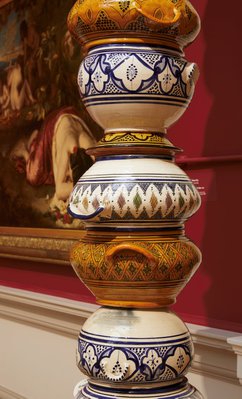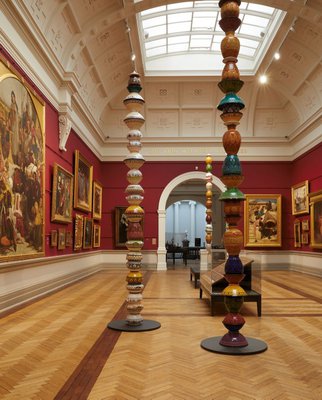

-
Details
- Date
- 2012
- Media category
- Sculpture
- Materials used
- found Arabic pots with metal support
- Dimensions
-
display dimensions variable
:
A - Column A, 473 cm
B - Column B, 478 cm
C - Column C, 415 cm
D - Column D, 526 cm
E - Column E, 555 cm
- Credit
- Purchased with funds provided by the Art Gallery Society and the Jim and Mollie Gowing Bequest 2021
- Location
- South Building, ground level, Grand Courts
- Accession number
- 194.2021.a-e
- Copyright
- © Pascale Marthine Tayou
- Artist information
-
Pascale Marthine Tayou
Works in the collection
- Share
-
-
About
Pascale Marthine Tayou’s home country of Cameroon is a locus for ethnic and linguistic diversity in Africa, with more than 200 languages and multiple religions and communities. This multi-culturalism is reflected in his artworks which often act as a point of mediation or exchange between different cultures and which comment on the global circulation of ideas and objects, both historical and contemporary.
Found and recycled materials are hallmarks of Tayou’s practice. He often masses together discarded objects, repurposing them to create beguiling and often monumental sculptural forms that draw attention to a world of accelerated production and exchange.
Colonne Pascale was originally created for the 2012 edition of the Marrakech Biennale. Made from ceramic vessels found by the artist and assembled into five towering columns, the work has an delicate yet majestic physical presence. From a distance, the columns’ elegantly undulating forms evoke modernist sculpture and architecture, while, on closer inspection, the uniqueness of each vessel comes to the fore. Their shapes, decorations and imperfections speak to individual histories of use and personal narratives.
-
Exhibition history
Shown in 1 exhibition
Grand Courts collection rehang, Art Gallery of New South Wales, Sydney, Nov 2021–2023
